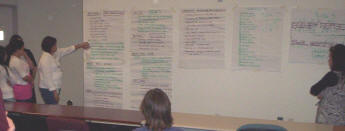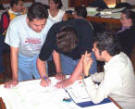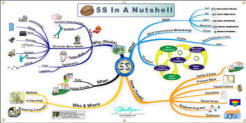5S Implementation
5S Fast & Simple
Introduction
5S can be fast and simple. Ninety percent of the benefits can flow from a few simple forms, procedures and techniques combined with plenty of action.
We recommend two stages for implementation. This allows work teams to experience results quickly and generates enthusiasm. It promotes learning in manageable steps that combine theory and practice with the emphasis on practice. It uses many principles of Action Learning.
Stage I
Stage I of 5S emphasizes cleanliness, housekeeping and convenience. Improvements in efficiency, motion economy and process are basic and, mostly, limited to individual workstations. Or, in 5S terms, Sorting, Shining and basic Setting. Training is short, team planning limited and action is quick. Standardization activity is also basic and limited to maintaining the initial levels of cleanliness. Stage I also includes a steering committee to begin Sustainment. Our workshop, "5S Fast & Simple" implements Phase I in two days. This does not have to be difficult or complex. The bias should be on action and participation. To see a typical schedule, click here.

Stage II
 Stage
II builds on the skills and experience of Stage I. It assumes that Sort and Shine have been
maintained and that most of the Set activities for individual workstations are correct. Stage II
training emphasizes layout of the area, Ergonomics and advanced Motion Economy. It also extends
Standardization activities beyond 5S maintenance and into production tasks, safety or other
activities where work standardization is useful. It may include Team Development training.
Stage
II builds on the skills and experience of Stage I. It assumes that Sort and Shine have been
maintained and that most of the Set activities for individual workstations are correct. Stage II
training emphasizes layout of the area, Ergonomics and advanced Motion Economy. It also extends
Standardization activities beyond 5S maintenance and into production tasks, safety or other
activities where work standardization is useful. It may include Team Development training.
Useful Tools
Banners & Posters
These can change culture and attitudes but only when accompanied by management action and support. People need the knowledge of 5S tools and the resources to use them. Without such backup, employees view banners and posters as just another example of management hypocrisy.
Kaizen Events (Blitz)
Kaizen Events are short, highly focused projects for improving some aspect of a work area. They generally include training followed by or concurrent with analysis and implementation.
Quick & Easy Kaizen
Originated by Toyota and popularized by Norman Bodek, Quick & Easy Kaizen (or Mini-Kaizen) can supplement 5S activities.
Planning The Implementation
5S Teams
-
The purpose of these teams is to implement 5S improvements in their own areas.
-
The team should have about 5-12 members.
-
The core group of a 5S team consists of people who work together in a contiguous area or department.
-
People from support areas such as engineering, maintenance or supervision can supplement teams for the initial kaizen event. This is a useful way to train those people who will not participate in daily 5S activities but need to understand the program.
Steering Committee
-
The purpose of the committee is to coordinate activities, set policies, and sustain the 5S program.
-
The committee should have about 5-15 members.
-
Membership is representative of all organizational levels and most areas of the operation.
-
Members should participate in initial training and serve temporarily on 5S teams to observe activities.
5S Coordinator
The 5S Coordinator assists 5S Teams, may facilitate kaizen events, conducts training and executes the directions and policies of the Steering Committee.
Management Champion
The Management Champion is a senior manager who provides resources and support the for 5S program.
Stage I Kaizen Events
 In
a Stage I kaizen event, participants are organized into 5S teams (see above). Managers,
supervisors and support staff supplement core teams for learning purposes. Up to eight teams and
60 people can participate in a session and the event normally runs for two days.
In
a Stage I kaizen event, participants are organized into 5S teams (see above). Managers,
supervisors and support staff supplement core teams for learning purposes. Up to eight teams and
60 people can participate in a session and the event normally runs for two days.
Training occurs during the first half day. This training introduces 5S and basic 5S tools. After the formal training, the teams spend an hour or so planning and organizing their project. Each team presents its plan to the other groups.
Teams then move to the plant floor and execute the first of the 5S'-- Sort, Shine and Set. Several general sessions are held to report progress and the facilitator and managers visit each team as the work progresses. Near the end of the second day, the teams complete their work and report to management and the other teams in a plenary session.
While the 5S teams are executing their projects, the steering committee holds several meetings to determine their course of action. They decide on sustainment methods, initial policies and standards for 5S teams.
The 5S Coordinator works with all teams to ensure they have adequate tools and supplies. The training facilitator assists teams with decision making and organization. The Management Champion offers encouragement and support.
Stage II Kaizen Events
Stage II Kaizen Events should occur several weeks or months after the stage I event. Stage II events may require 2-5 days and the emphasis is on advanced tools. The initial training, analysis and team project planning consumes most of the first day. Such an event may include the rearrangement of equipment or the construction of special tools.
After the training and planning, the event is executed in a manner similar to the Stage I event but the time required may be longer. Stage II events are more focused and only a few teams hold events simultaneously.

■ ■ ■ ■ ■ ■ ■



